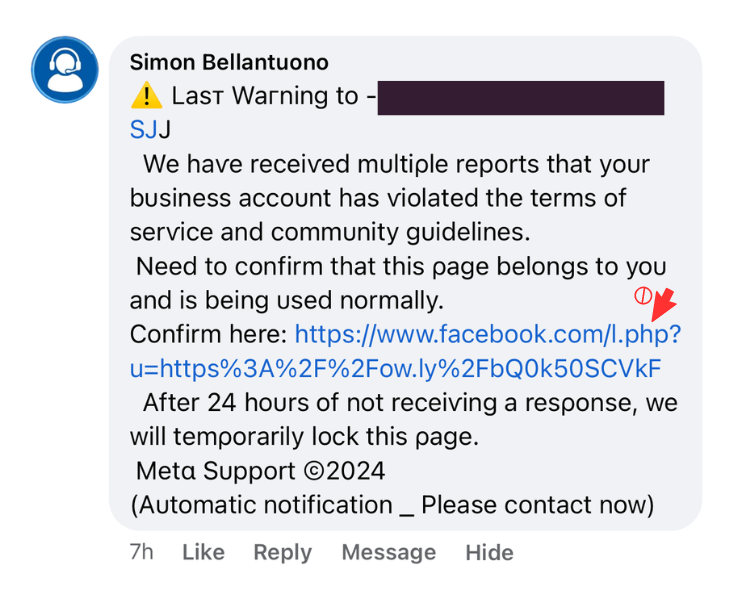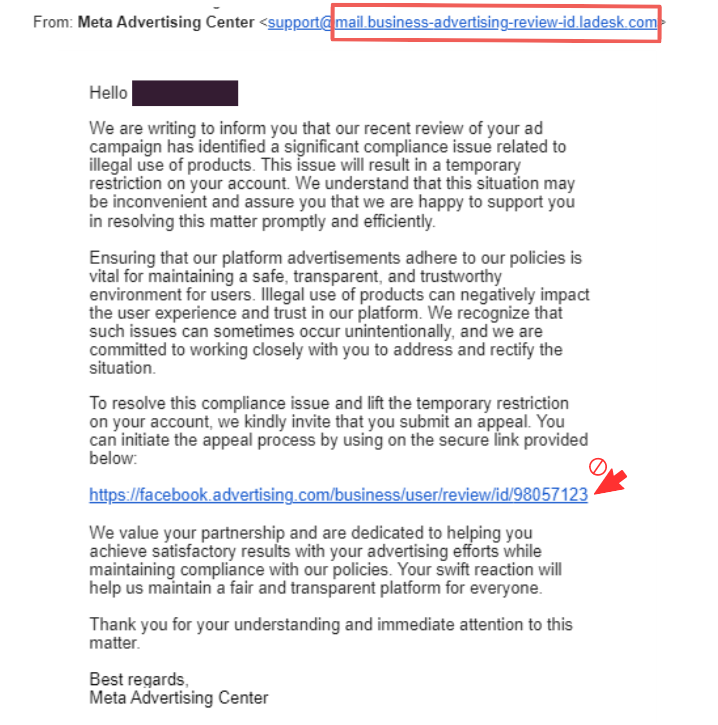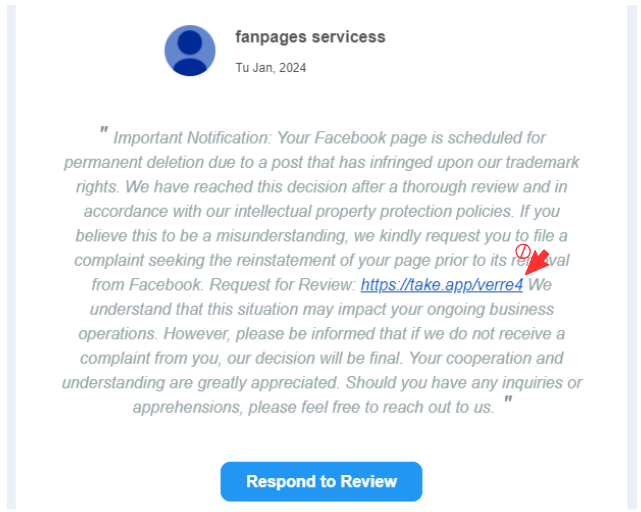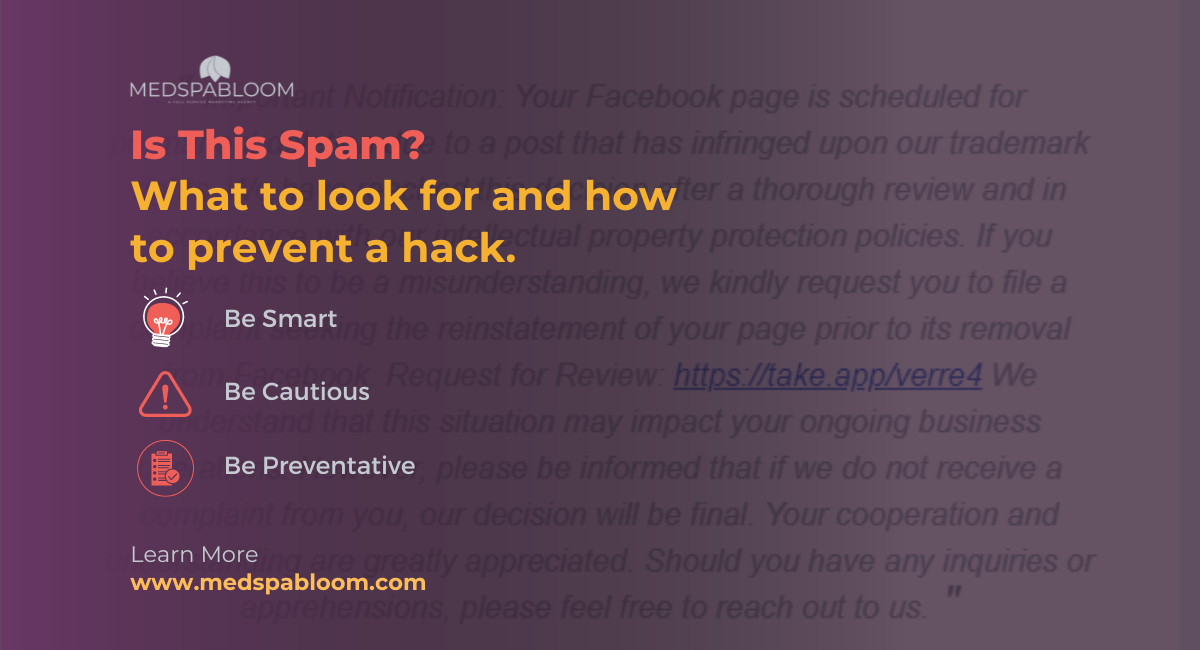In today’s digital world, staying safe online is crucial, especially for medspas who are advertising online. As a Senior Account Manager at MedspaBloom, I am frequently asked about how to differentiate between legitimate messages and spam or phishing attempts. Today, I’ll share some valuable tips on recognizing spam and preventing hacks to ensure your medspa’s online presence remains secure.
Identifying Spam
Spam attempts often come disguised as genuine messages, which can be misleading. Here are some common forms of spam you might encounter:
1. Social Media Messages
Direct messages on platforms like Facebook and Instagram are common channels for spam. A typical example might involve a message that looks legitimate, often including your medspa’s name and references to official entities like Meta Support. However, these messages often contain suspicious links.

How to Spot It:
- Check the Link: If the URL after “facebook.com” includes a string of random letters and symbols, it’s likely spam. Always verify the URL by searching for official Facebook contact links directly from Facebook.
- Do NOT Click Links: Avoid clicking any links in such messages. Instead, navigate to the official site directly or reach out to an expert at MedspaBloom.
2. Emails
Spam emails can also appear convincing. They might come from addresses that seem official, such as Meta Advertising Center or use your medspa’s name. To verify the authenticity, examine the domain after the “@” symbol in the email address.

How to Spot It:
- Examine the Domain: Legitimate emails from Facebook or Meta will come from domains like @facebookmail.com, @fb.com, @meta.com, or @metamail.com. Always be on the lookout for any deviation, like a missing letter or a misspelled word. These are both immediate red flags.
- Avoid Suspicious Links: Similar to direct messages, if an email contains dubious links, don’t click them. Report and delete these emails.
3. Review Sites
Spam can also appear in your medspa reviews. Often, these reviews contain spammy links that can compromise your account’s security.

How to Spot It:
- Scrutinize Links: If a review contains links that seem out of place or suspicious, it’s best to avoid interacting with them.
Steps to Protect Your Accounts
Protecting your medspa’s accounts from spam and hacking attempts involves several key practices:
1. Enable Two-Factor Authentication
Two-factor authentication (2FA) adds an extra layer of security to your accounts. Here’s how to enable it:
- For Facebook:
- Go to your profile and click on “Settings and Privacy.”
- Select “Settings,” then “Account Center,” and click on “Password and Security.”
- Choose “Two-Factor Authentication” and follow the instructions to set it up using your mobile phone number.
2. Set Up Business Notifications
Enable notifications to stay updated on any suspicious activities:
- For Facebook Business Manager Notifications:
- Go to facebook.com and open “Business Settings.”
- Click on “Notifications” and select the types of updates you want to receive.
- Toggle on the notifications for the business manager and other relevant updates.
3. Create Strong Passwords
Use strong and complex passwords for all your accounts associated with your medspa. A good password should include a mix of letters, numbers, and special characters. Avoid using easily guessable information like birthdays or common words related to your account or medspa.
4. Regular Account Reviews
Regularly review your account settings and activity to ensure there are no unauthorized changes or access.
Conclusion
Spam and phishing attempts can be sophisticated and convincing, but by staying vigilant and following these security practices, you can protect your medspa from potential threats. If you’re ever in doubt about the legitimacy of a message or email, don’t hesitate to consult with the experts MedspaBloom. We’re here to help you navigate these challenges and keep your accounts associated with your medspa safe.
For more tips and personalized advice on securing your online presence, feel free to reach out to us at MedspaBloom. Stay safe and secure online!
Interested In More?
Join our marketing membership program for only $199/mo to get access to unlimited online medspa marketing courses released each month, latest medspa marketing trends, and what’s working, how-to guides and step-by-step tutorials for medspa marketing, industry news, and how it affects your medspa, new software and tools and how to use them, and full access to our all-in-one marketing software (HighLevel) setup with pre-built marketing templates just for medspas.
Connect with us:
Share this content:
